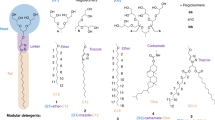Abstract
Membrane proteins are typically expressed in heterologous systems with a view to in vitro characterization. A critical step in the preparation of membrane proteins after expression in any system is the solubilization of the protein in aqueous solution, typically using detergents and lipids, to obtain the protein in a form suitable for purification, structural or functional analysis. This process is particularly difficult as the objective is to prepare the protein in an unnatural environment, a protein detergent complex, separating it from its natural lipid partners while causing the minimum destabilization or modification of the structure. Although the process is difficult, and relatively hard to master, an increasing number of membrane proteins have been successfully isolated after expression in a wide variety of systems. In this chapter we give a general protocol for preparing protein detergent complexes that is aimed at guiding the reader through the different critical steps. In the second part of the chapter we illustrate how to analyze the composition of protein detergent complexes; this analysis is important as it has been found that compositional variation often causes irreproducible results.
Access this chapter
Tax calculation will be finalised at checkout
Purchases are for personal use only
Similar content being viewed by others
References
Palsdottir H, Hunte C (2004) Lipids in membrane protein structures. Biochim Biophys Acta 1666(1–2):2–18. doi:10.1016/j.bbamem.2004.06.012
Goormaghtigh E, Raussens V, Ruysschaert JM (1999) Attenuated total reflection infrared spectroscopy of proteins and lipids in biological membranes. Biochim Biophys Acta 1422(2):105–185. doi:10.1016/S0304-4157(99)00004-0
Hancock REW (1999) Hancock laboratory methods (visited July 2015). http://www.cmdr.ubc.ca/bobh/methods.htm
Niederman RA, Gibson KD (1971) The separation of chromatophores from the cell envelope in Rhodopseudomonas spheroides. Prep Biochem 1(2):141–150
Jarosławski S, Duquesne K, Sturgis JN, Scheuring S (2009) High-resolution architecture of the outer membrane of the Gram-negative bacteria Roseobacter denitrificans. Mol Microbiol 74(5):1211–1222. doi:10.1111/j.1365-2958.2009.06926.x
Deisenhofer J, Epp O, Miki K, Huber R, Michel H (1984) X-ray structure analysis of a membrane protein complex. Electron density map at 3 A resolution and a model of the chromophores of the photosynthetic reaction center from Rhodopseudomonas viridis. J Mol Biol 180(2):385–398
Ebel C (2011) Sedimentation velocity to characterize surfactants and solubilized membrane proteins. Methods 54(1):56–66. doi:10.1016/j.ymeth.2010.11.003
Fleming KG (2008) Determination of membrane protein molecular weight using sedimentation equilibrium analytical ultracentrifugation. Curr Protoc Protein Sci Chapter 7:Unit 7.12.1–7.12.13. doi:10.1002/0471140864.ps0712s53
Le Maire M, Champeil P, Møller JV (2000) Interaction of membrane proteins and lipids with solubilizing detergents. Biochim Biophys Acta 1508(1–2):86–111
Focher B, Savelli G, Torri G, Vecchio G, McKenzie D, Nicoli D, Bunton C (1989) Micelles of 1-alkyl glucoside and maltoside: anomeric effects on structure and induced chirality. Chem Phys Lett 158(6):491–494
Anatrace (2015) Anatrace company web site (visited July 2015). http://www.anatrace.com
Sigma Aldrich (2015) Sigma Aldrich company web site (visited July 2015). http://www.sigmaaldrich.com
Lin TL, Chen SH, Roberts MF (1987) Thermodynamic analyses of the structure and growth of asymmetric linear short-chain lecithin micelles based on small-angle neutron scattering data. J Am Chem Soc 109(8):2321–2328. doi:10.1021/ja00242a013
Clarke JA, Heron AJ, Seddon JM, Law RV (2006) The diversity of the liquid ordered (Lo) phase of phosphatidylcholine/cholesterol membranes: a variable temperature multinuclear solid-state NMR and x-ray diffraction study. Biophys J 90(7):2383–2393. doi:10.1529/biophysj.104.056499
Keller S, Heerklotz H, Jahnke N, Blume A (2006) Thermodynamics of lipid membrane solubilization by sodium dodecyl sulfate. Biophys J 90(12):4509–4521. doi:10.1529/biophysj.105.077867
Sot J, Manni MM, Viguera AR, Castaneda V, Cano A, Alonso C, Gil D, Valle M, Alonso A, Goni FM (2014) High-melting lipid mixtures and the origin of detergent-resistant membranes studied with temperature-solubilization diagrams. Biophys J 107(12):2828–2837. doi:10.1016/j.bpj.2014.10.063
Lichtenberg D, Ahyayauch H, Goni FM (2013) The mechanism of detergent solubilization of lipid bilayers. Biophys J 105(2):289–299. doi:10.1016/j.bpj.2013.06.007
DaCosta CJB, Baenziger JE (2003) A rapid method for assessing lipid:protein and detergent:protein ratios in membrane-protein crystallization. Acta Crystallogr D Biol Crystallogr 59(1):77–83. doi:10.1107/S0907444902019236
DuBois M, Gilles KA, Hamilton JK, Rebers PA, Smith F (1956) Colorimetric method for determination of sugars and related substances. Anal Chem 28(3):350–356. doi:10.1021/ac60111a017
Duquesne K, Sturgis JN (2010) Membrane protein solubilization. Methods Mol Biol (Clifton, NJ) 601:205–217. doi:10.1007/978-1-60761-344-213
Taussky HH, Shorr E (1953) A microcalorimetric method for the determination of inorganic phosphorous. J Biol Chem 202:675–685
Bradford MM (1976) A rapid and sensitive method for the quantitation of microgram quantities of protein utilizing the principle of protein-dye binding. Anal Biochem 72:248–254. doi:10.1016/0003-2697(76)90527-3
Popot JL (2014) Amphipols: where from? Where to? J Membr Biol 247(9-10):755–757
Breyton C, Gabel F, Abla M, Pierre Y, Lebaupain F, Durand G, Jl P, Ebel C, Pucci B (2009) Micellar and biochemical properties of (hemi)fluorinated surfactants are controlled by the size of the polar head. Biophys J 97(4):1077–1086. doi:10.1016/j.bpj.2009.05.053
Bayburt TH, Grinkova YV, Sligar SG (2002) Self-assembly of discoidal phospholipid bilayer nanoparticles with membrane scaffold proteins. Nano Lett 2(8):853–856. doi:10.1021/nl025623k
Knowles TJ, Finka R, Smith C, Lin YP, Dafforn T, Overduin M (2009) Membrane proteins solubilized intact in lipid containing nanoparticles bounded by styrene maleic acid copolymer. J Am Chem Soc 131(22):7484–7485. doi:10.1021/ja810046q
Scheidelaar S, Koorengevel MC, Pardo JD, Meeldijk JD, Breukink E, Killian JA (2015) Molecular model for the solubilization of membranes into nanodisks by styrene maleic acid copolymers. Biophys J 108(2):279–290. doi:10.1016/j.bpj.2014.11.3464
Author information
Authors and Affiliations
Corresponding author
Editor information
Editors and Affiliations
Rights and permissions
Copyright information
© 2016 Springer Science+Business Media New York
About this protocol
Cite this protocol
Duquesne, K., Prima, V., Sturgis, J.N. (2016). Membrane Protein Solubilization and Composition of Protein Detergent Complexes. In: Mus-Veteau, I. (eds) Heterologous Expression of Membrane Proteins. Methods in Molecular Biology, vol 1432. Humana Press, New York, NY. https://doi.org/10.1007/978-1-4939-3637-3_15
Download citation
DOI: https://doi.org/10.1007/978-1-4939-3637-3_15
Published:
Publisher Name: Humana Press, New York, NY
Print ISBN: 978-1-4939-3635-9
Online ISBN: 978-1-4939-3637-3
eBook Packages: Springer Protocols




